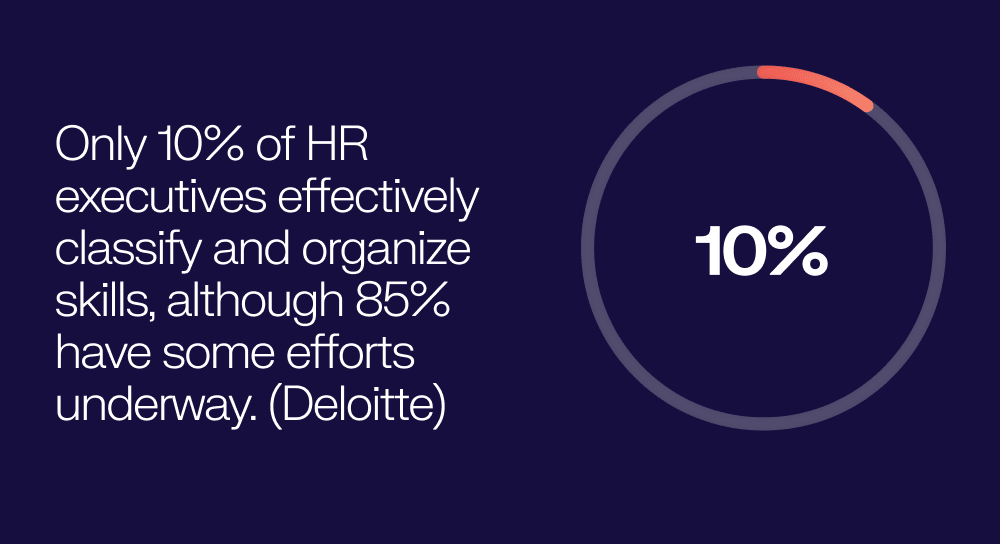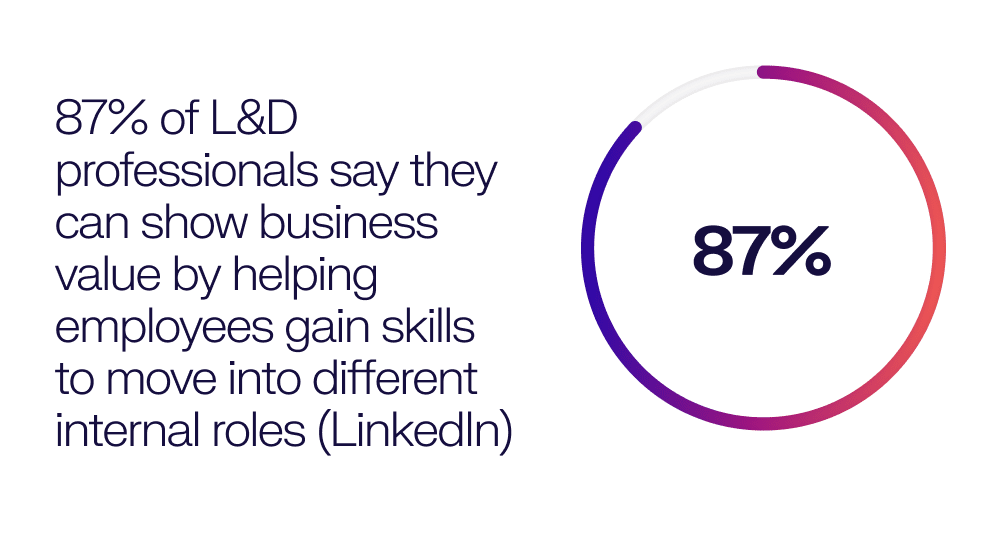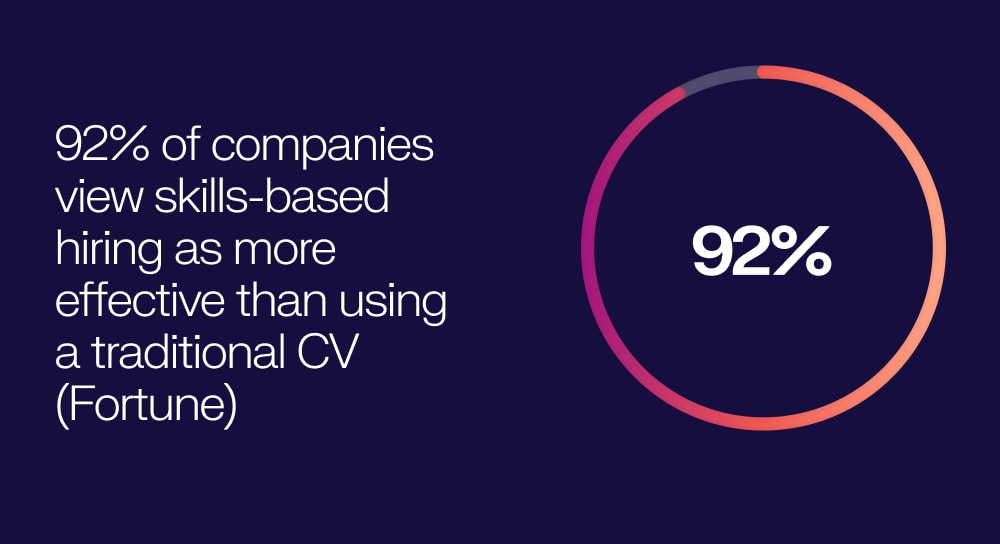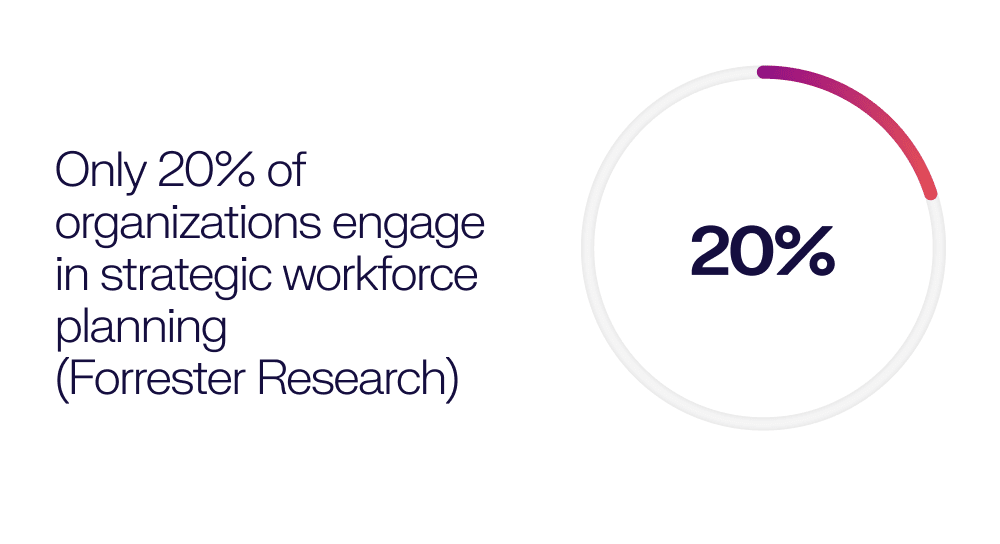How To Fill Skills Gaps In 2025
Closing skills gaps is crucial for companies to stay competitive, foster innovation, and ensure workforce adaptability.

Economists predict that difficulty finding talent will be with us for at least the next decade and beyond. Not having the talent to sustain and grow the business will cost global economies over $8.3 trillion dollars by 2030, according to Korn Ferry.
Meanwhile, the World Economic Forum has estimated that automation will displace 85 million jobs by 2025, and 40% of core skills will change for workers.
The biggest risk to any business today is not having the right people, with the right skills, in the relevant roles. CEOs, and CHROs, need to make big bets, be more strategic with data than ever, and directly feed into business plans. They need new ways to close skills gaps through unlocking human potential.
So how can businesses address skills gaps effectively?
1. Assess The Current Skills Landscape 👀
Before diving in to solve the problem, you need to ensure you understand the scale and nature of the challenge – on an ongoing basis.

Doing a one-off skills audit is fine, but – due to the ever-changing nature of work – most large enterprises would benefit from a dynamic, real-time view of the skills they have, the skills they need today, and the skills they are most likely to need tomorrow.
In addition to your regular performance evaluations, feedback loops, and assessments, AI-powered tools can help you better understand the skills your workforce (and wider talent pool possesses) – even as they learn and develop.
- AI can normalize the data that comes from people’s own resumes and work profiles
- AI can infer the skills someone is likely to have based on their previous experiences (work or training or something else)
- AI can also suggest where people have potential to add a new skill (it would be adjacent to skills they possess currently)
- AI can then pinpoint where internal mobility or training, versus external hiring, would be the best hiring tactic
The way to get this working is to ensure your skills data lives in one place – you have a single source of truth for the AI to work on. Connected skills intelligence (about people and about jobs) is now the foundation for a more dynamic and effective approach to acquiring, managing and retaining talent.
“Skills intelligence is an evolution of core HR data. We see skills as the next layer of maturity in our talent acquisition function, driving the evolution of how we identify and attract talent.” – Art Lokerson, HR Product Management Director – Talent Acquisition, Wells Fargo
2. Develop Internal Talent 💗
While CEOs panic about not being able to find the talent they need – whether its emerging “green skills”, expertise with AI, or another scarce but crucial skill – they rarely look within. Even when (e.g. brand new) necessary skillsets are not prevalent in your existing workforce, there will be plenty of employees with potential.

With the deep, dynamic insights you have relating to skills, you can start to make connections between the people with the aptitude and willingness to learn new things (and the core skills needed for a role, perhaps), with the programs or gigs that would help them best develop.
Provide access to e-learning platforms like Coursera, LinkedIn Learning, Udemy, or internal knowledge-sharing portals. Can you offer financial support for employees pursuing formal education or advanced certifications?
Offer continuous learning through formal training, workshops, or certification programs (e.g., leadership, technical skills, soft skills). Foster a culture of continuous improvement and personal development by encouraging employees to seek new knowledge.
Encourage internal mobility, job rotation and cross-functional training to allow employees to develop diverse skill sets. Pair less experienced employees with more seasoned professionals to facilitate knowledge transfer and development of new skills.
Incorporate data literacy, digital tools, or AI training for broader tech adoption. While 82 percent of leaders say their employees will need to develop new skills to work with AI, only 38 percent of companies are offering training in AI literacy (LinkedIn).
Ensure you track employee learning progress and continue to tailor training to individual needs.

Technology today can help you:
- Spot where employees are disengaged, or a “flight risk”
- Identify internal talent pools with the potential to upskill or reskill
- Align development opportunities with people’s needs, with little manual effort
- “Design” personalized training programs
- Deliver training that is customized to an individual’s learning style
- Update employee profiles automatically when someone e.g. completes a course
This is all straightforward if your talent data is well managed. Use a smart AI-powered talent database to keep track of your entire talent pool – the people who have applied in the past, silver medallists, alumni, people you have approached on LinkedIn, as well as your existing workforce. What skills do they have today, and where do they have potential to grow?
“Ideally our entire workforce should be part of our talent pool, and now that we are putting a content-based and skill-based job role architecture in place across our entire footprint, it gives us a totally different visibility of what we actually have access to.” – Stefan Begall, VP & Group Head of Talent, Telia
3. Widen The Pool With Skills-Based Hiring 🌐
Connected skills insights can also be used to find a more efficient, inclusive and effective form of Talent Acquisition – skills-based hiring.
Looking at candidates through the lens of the specific skills and competencies they bring to the table, rather than ‘traditional’ factors like where someone studied, or previous job titles, is key.
“When I took over the Talent Acquisition side, one of the things that we really wanted to do is base our search of talent in skills. Because I was definitely, definitely sure that that was the future… skills would be the future currency of talent.” – Fernando Bellon, BBVA
This approach also requires a rethink about how we define work and jobs. When looking at role descriptions, break down the work into constituent tasks, identifying the skills needed to complete those tasks.
Again, smart AI can help here – there is no real way to do this manually if you are a large, ever-changing enterprise company. A (dynamic and contextual) Job Architecture will keep you right.
When hiring, prioritize adaptability, potential for growth, and willingness to learn over rigid experience requirements.
Of course, this doesn’t need to be applied only to permanent, full-time hires. Engage outside experts or freelancers to fill short-term skills gaps while internal talent is being developed, using the same approach.
You can also analyze the supply of relevant skills when entering a brand new market. Explore where skills are more abundant and/or affordable in order to develop hiring location strategies and even wider business plans.

4. Embrace Dynamic Workforce & Succession Planning 🔮
“If you looked five, six, seven years ago, who would have thought data science would be such an integral role across essentially all our lines of business, but if we had the skills insights then as we do today, we could anticipate and drive and build that capacity for when the need actually arises.” – Art Lokerson, Wells Fargo
One issue faced by many large organizations is outdated workforce planning practices. A static plan developed over months (often by costly consultants) is no longer a smart way to prepare your business and fill skills gaps.
Today’s technology can deliver dynamic workforce plans, with AI-powered tools giving HR and managers continuous insights around how best to develop their team’s skill portfolio, when to hire (and the likely costs), and when it’s faster or more efficient to source internally, upskill workers, or open a short-term project or gig.
This real-time intelligence can even be provided in the “flow of work”, inside platforms like Slack and Microsoft Teams, making it easier and faster for leaders to make the right talent decisions.

Take time to develop future leaders by offering leadership development programs to high-potential employees, and ensure that key positions have backup talent in place with the necessary skills – through personalized and highly relevant training and career development paths. This is easier than ever with connected skills data and AI-powered tools.
“Having the ability to know what skills you have in your company, then predict what skills you’re going to need in the future, and filling the gap, is really how your company is going to grow or change or transform.” – Jacqui Canney, ServiceNow
5. Monitor Industry Trends & Use Your Influence 📰
This is really about looking ahead: being part of the movement to encourage the development of the skills you will need in the future.
Partner with universities, colleges and vocational schools to design a curriculum that aligns with industry needs. Advocate for policies that incentivise skills development. Engage with policymakers, where possible and appropriate, to ensure support and funding for vocational training and apprenticeships.
Regularly monitor industry trends and technological advancements, in order to anticipate future skills that will be in demand. Join industry associations and advisory boards to gain insights, or consider embedding insights about the wider labor market into your own talent management tools. This way, data about emerging skills, competitor activity and salary benchmarks can really easily inform your own planning and decision making around talent.
By focusing on both internal development and external solutions, and with the right data and technology, your company can systematically reduce skills gaps… and build a workforce prepared for future challenges.